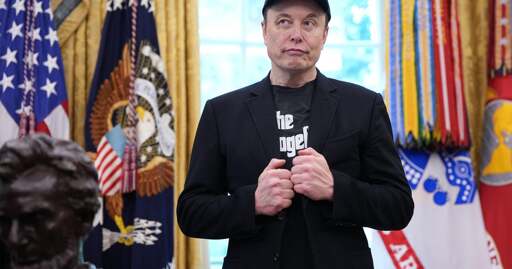Trump may launch Trump-branded mobile phone and a wireless service that could compete with the likes of Verizon, AT&T, and T-Mobile.
-
The only reason it will compete with those brands is cause if some kind of agreement.
-
Thank God the swamp is gone.
-
Lol, yeah this doesn't scream android phone full of spyware at all! It's definitely not going to just be a rebranded Chinese made phone that we assemble in like Louisiana and can say is "American made"
Nah. He'll just have the sticker that says "American made" made in America.
-
This is just todays stupid idea, just to take peoples attention away from yesterdays shitty "perade"(sic).
-
Nah. He'll just have the sticker that says "American made" made in America.
Worse he's promising that they'll eventually be made in America. Just like he promised a new health care plan
-
o look, more illegal shit. great.
-
Came to say this - either its going to use existing infrastructure owned by those companies, or it's going to completely suck. In neither case that's competition
Oh it's 100% gonna be an MVNO, it's expensive as fuck to roll out new infrastructure, and something like that certainly wouldn't go unnoticed anyway.
It's just gonna be the worst shit-tier kind of MVNO. Like Cricket back in the 2000s. Service = maybe.
-
Damn he’s milking every penny. Did he just discover late stage capitalism?
-
No matter what your stance on Trump is, you must agree that it isn't completely outside the realm of possibilities.
He took the KISS method of advertising/marketing. Slap the brand name on everything you can to squeeze out as much money from the "fan base"as possible
-
Damn he’s milking every penny. Did he just discover late stage capitalism?
He already sold beans in the oval office, golden shoes and shitcoins. I think he's way past discovering it.
-
A president is allowed to found companies?
Either way, he sure has time on his hands.
It's crazy how taxing that job must be.
-
Nah. He'll just have the sticker that says "American made" made in America.
And by american made it means designed by a guy in america usin A.I, droppshipping it from china.
-
If by "everyone" you mean the people stupid enough to buy a made-in-China Trump phone.
Oh no a made in china phone. What a horrible thought.
-
Compete with them will using their networks, sure.
-
Register his own root Certificate Authority as well and this man is well on his way towards global surveillance.
-
Lol please let every Trump supporter buy his service. Suddenly, Trump ass kissers will have less reliable access to the internet and phone service?! Sounds like a good idea to me.
-
It's literally a political franchise.
Despite the stupidity of looks, to be honest - this looks from outside very US-American. Not like cowboy movies, not even like 30s, but like something written by Baum.
-
Oh no a made in china phone. What a horrible thought.
The point is not that there's anything inherently wrong with a Chinese phone, but that they're lying by saying it's designed and manufactured in the USA. It is neither.
-
are you saying all my Trumpcoins, Trump NFTs, degrees from Trump university and deep frozen Trump steaks are worthless
Just drink some Popov grade Trump Vodka at one of his many totally not bankrupt casinos to take your mind off of it.





